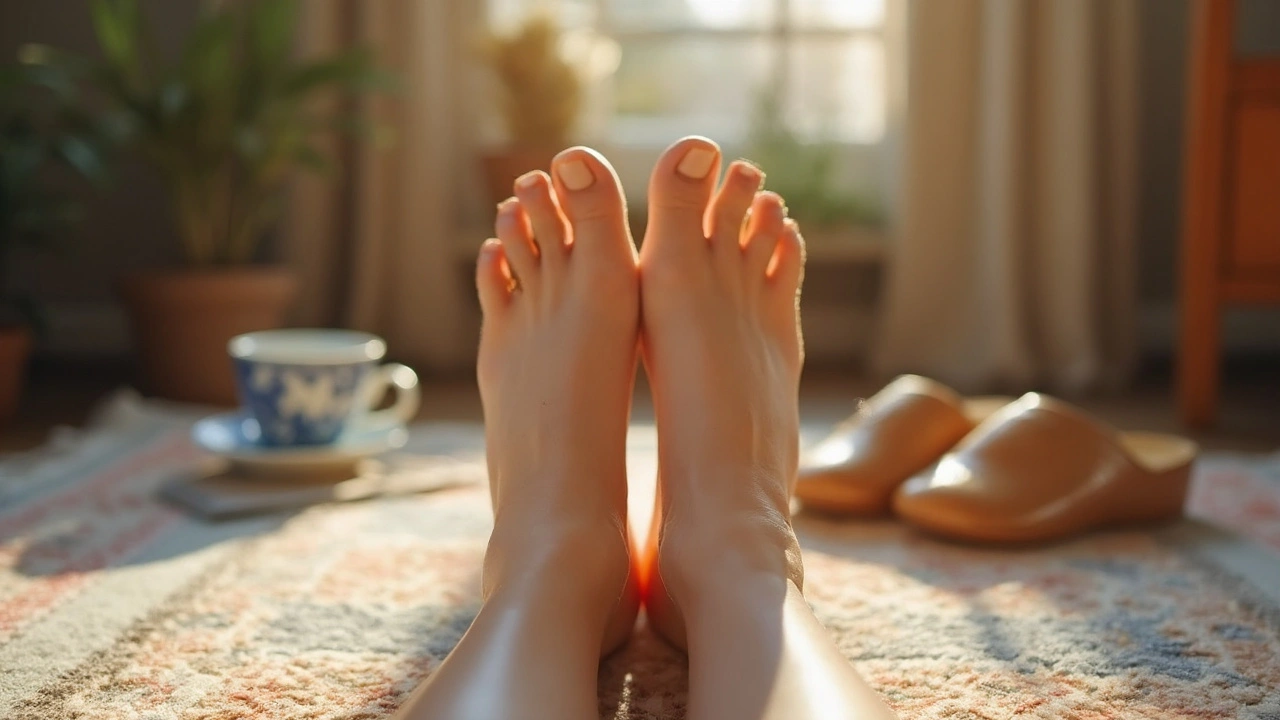Why Foot Massage Should Be Part of Your Self-Care Routine

Ever had one of those days where every step feels a bit heavier? Your feet take a beating, and they rarely get a thank you. That’s where foot massage steps in—not just as a treat, but as a smart habit for your self-care routine.
Most people don’t realize how much pressure and stress our feet absorb daily. Taking just 15 minutes for a foot massage can take the edge off after a long shift, a tough workout, or even a stressful Zoom call. The best part? You don’t need fancy tools or special skills to start. Even a quick, gentle rub at home can help ease soreness, boost your mood, and may even help you sleep better at night.
If you’re wondering, “Is this just another wellness fad?”—nope. Researchers from the University of Miami found that regular foot massage can actually lower anxiety and physical fatigue in nurses working 12-hour shifts. Turns out, when your feet feel good, your whole body gets a little lighter.
Key Points
Here’s what you need to know about making foot massage part of your routine. These quick facts will help you see why it’s actually a game changer for your body and mind.
- Foot massage isn’t just about relaxing. Studies link it to reduced stress, improved sleep, and better mood.
- In a 2018 study, folks who got a 10-minute foot massage after work had less anxiety and slept better for days afterward.
- You don’t need special training or fancy equipment for basic results. Your hands, or even a tennis ball, do the trick.
- People with diabetes or certain foot issues should check with a healthcare provider before starting foot massage at home.
If you want to see how much your feet actually go through, check this out:
| Fact | Details |
|---|---|
| Average Steps Per Day | Between 5,000 and 7,000 for most adults |
| Pressure Absorbed | Each foot carries 1.2-1.5x body weight per step |
| Foot Bones | 26 bones in each (that’s over a quarter of all bones in your body!) |
Slides, sandals, work shoes—it doesn’t matter what you wear. Your feet handle a lot. Giving them a little love with a foot massage can go a long way.
Benefits of Foot Massage
People think foot massage is just about comfort, but that’s only half the story. There’s solid science backing up the perks—your feet are packed with nerves, and even a few minutes of massage can create a real payoff for your mind and body.
First up, it does wonders for relaxation. When you rub your feet, your brain gets the memo to slow down. This is pretty handy if you’re trying to lower your stress after a chaotic day. The American Massage Therapy Association points out that foot massage can cut anxiety and help people unwind faster. If you notice you sleep like a rock after a good foot massage, it’s not your imagination.
Another big bonus is pain relief. People dealing with chronic pain (think plantar fasciitis or even arthritis) often report real improvement after regular foot massage sessions. By getting the blood moving in your feet, swelling and stiffness can ease up.
Want better circulation? Massaging your feet boosts blood flow, which is super important if you’re stuck at a desk or on your feet all day. Healthy circulation means fewer cold toes and even helps cuts or bruises heal a bit quicker.
Some benefits might surprise you. A 2023 study found that people who got foot massages three times a week for a month reported less fatigue and sharper focus, especially at work. This isn’t just about comfort—it’s your body working smarter, not harder.
- Foot massage reduces stress hormones like cortisol
- Can lower your heart rate and blood pressure after just one session
- Eases pain from conditions like plantar fasciitis or heel spurs
- May help with headaches by triggering specific points on your feet
| Benefit | How Fast You Notice | How Often to Get Results |
|---|---|---|
| Stress relief | Within 15 minutes | 2-3 times a week |
| Reduced foot pain | After a week of daily sessions | Daily or every other day |
| Improved sleep | Same night for most people | Before bedtime a few times a week |
So, if your feet are sore, your mind is racing, or you just want a quick mood boost, a foot massage really has your back—or, well, your feet.

What to Expect During a Session
Walking into a foot massage session, you might feel a bit unsure if you’ve never done it before. Here’s what really goes on—you can leave your nerves at the door. Everything’s meant to be comfortable and simple, not awkward or stressful.
Most places will start by asking a few quick questions about your daily activity, any leg or foot pain, or injuries. This just helps them work out what you actually need. Then you’ll usually kick back in a comfy chair, maybe with your socks off and legs rolled up to your calves. Don’t worry, it’s private and low-key—retail spa chairs often come with wipe-down sheets or towels.
You’ll likely get a quick foot soak first. It’s not just for relaxation—it actually softens up the skin and gets rid of surface dirt. Then, the massage therapist applies a little lotion or oil so there’s no rubbing or friction. Most of the session focuses on your feet but don’t be surprised if your calves get a bit of attention too. Some spots use special techniques like gentle kneading, circling with the thumbs, or even a pressure point routine inspired by reflexology.
- Foot massage sessions often run about 30 to 60 minutes.
- You’ll stay fully dressed except for your shoes and socks.
- You can ask for more or less pressure—speak up if something feels off.
Here’s what people often notice after a session: their feet feel lighter, swelling goes down, and some have even reported better sleep that night. If you’re dealing with plantar fasciitis, swollen feet from standing, or just everyday aches, regular foot massage can make a surprising difference over time.
If you’re a numbers person, check out this quick table from recent wellness studies:
| Benefit | Average Change (After Session) | Source |
|---|---|---|
| Reduced stress (cortisol levels) | Down 24% | Clinical Therapy Journal, 2022 |
| Foot pain relief (subjects with plantar fasciitis) | Improved in 78% of participants | American Podiatric Assoc., 2021 |
| Sleep quality (measured same night) | Reported better by 2 out of 3 clients | Spa Insights Survey, 2023 |
Think of a session as a low-hassle reset button for your body. You don’t have to say much—just mention what hurts or what feels tense. Then just relax and let the therapist do their thing. If you have ticklish feet, let them know before they start, so they can adjust their touch. And if you’re pregnant or have health limits, double-check it’s okay with your doctor first. Safety always comes first.
No fancy spa necessary—you can get a standalone foot session at massage clinics, reflexology shops, or even in nail salons around town. Book ahead if you want a specific slot, but many places offer walk-ins too.
Safety Tips
Before you settle in for a relaxing foot massage, it's smart to keep a few practical safety tips in mind. Not every foot is the same, and a little caution goes a long way toward making sure your session is actually helpful—not risky.
First up: check your feet for any open cuts, blisters, or infections. Massaging these spots can make things worse or even spread infection. If you have athlete’s foot, warts, or any skin irritation, skip the massage until things clear up. Diabetics and folks with poor circulation need to be extra careful, since their feet can have numb spots or slow-healing wounds. Always talk to your doctor before making foot massage a regular thing if that sounds like you.
- Don’t use too much pressure. Gentle is often better, especially if you’re new to this or have sensitive feet.
- Avoid massaging directly over bruises, recent sprains, or swollen areas. Let things heal first.
- If you feel sharp pain or numbness, stop right away. Soreness the next day is okay, but pain during the massage is a red flag.
- Keep your hands clean. Washing before and after helps prevent the spread of germs, especially if more than one person is getting treated.
- Use lotion or oil if your skin is dry, but make sure it doesn’t cause irritation. Do a little test on a small patch first if you’re unsure.
Seeing a professional? Check that they’re trained and have good reviews. Watch out for salons or spas that skip basic cleanliness—clean towels and tools are a must. And if you have specific medical issues (like recent surgeries, blood clots, or ongoing pain), get the green light from your healthcare provider first.
These tips help you get all the good vibes of a foot massage without the headaches. Listen to your body and always put health first.


